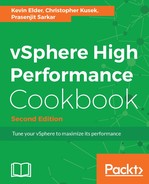So in the case of an SMP VM, if it demands high CPU resources, it may happen that either the application is single threaded, or the guest operating system is configured with uniprocessor HAL.
Many applications are written with only a single thread of control. These applications cannot take advantage of more than one processor core.
In order for a VM to take advantage of multiple vCPUs, the guest operating system running on the VM must be able to recognize and use multiple processor cores. If the VM is doing all of its work on vCPU0, the guest operating system might be configured with a kernel or HAL that can recognize only a single processor core.
In the preceding graph, the OS is sharing the load of the single-threaded application between both the available vCPUs.
You have two possible approaches to solve performance problems related to guest CPU saturation:
- Increase the CPU resources provided to the application
- Increase the efficiency with which the VM uses CPU resources
Adding CPU resources is often the easiest choice, particularly in a virtualized environment. If a VM continues to experience CPU saturation even after adding CPU resources, the tuning and behavior of the application and operating system should be investigated.
